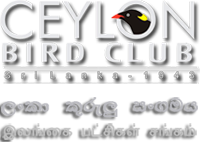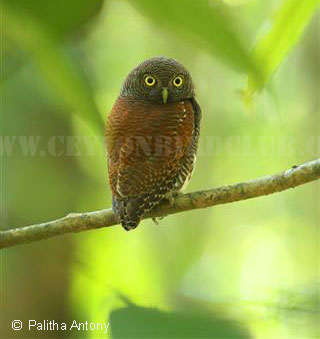


Chestnut-backed Owlet Glaucidium castanonotum
(Sri Lanka Chestnut-backed Owlet)
Sinhalese - Bassa
Tamil - Sinna Andai

This is a very attractive owl, with its dark barred chestnut mantle and wings, black and white radially barred head, horizontally barred breast which changes to vertical streaking on the abdomen.. The tail is black with seven fine horizontal bands of white. It is the size of the more familiar Scops Owl but has yellow eyes and no ear tufts. It is a rather scarce bird, being confined to the remaining tracts of wet zone forest and their outskirts ascending the wet hills to about 1800 metres. In common with its dry zone counterpart, the Jungle Owlet, it is quite diurnal in its habits, feeding well into the mornings. Due to this reason, though scarce, it can often be observed in suitable habitat. Kitulgala is a particularly good place to observe the species. The bird lives in pairs feeding on insects such as beetles. However when young have to be fed, it catches much larger fare. The call is a far carrying ,kaow,kaow kaow. The threateningsong is a krook krook ascending to a kaow, kaow and ending in a kao whap, kao whap.
The breeding season is in the early part of the year. No nests appear to have been found until senior Ceylon Bird Club member Dr T S U de Zylva found a pair nesting in a discarded woodpecker nest hole in a tree about ten metres up, close to Aluvihare, Matale in the Central Province in April 2001. There were two young present. Subsequently a nest was found in February 2006 in a natural cavity in a jak tree high up about 12 metres from ground level at Kitulgala. Ceylon Bird Club chairman Nanda Senanayake was able to carefully measure the eggs and found that these measurements were significantly less than given by Legge (supposedly of this species). The eggs are white in colour. The nests found so far have been located outside but close to forest. One such nest was in a disused woodpecker nest in a coconut palm.
Both adults feed the young visiting the nest every one and a half hours or so. A pair was observed to feed the young till at least 11.30 in the morning.
Regarding the feeding of the young, Ceylon Bird Club member Uditha Hettige writes in the CBCN March 2009, ‘when an adult arrived with food it perched on a nearby tree and uttered a screech. The chicks then replied in similar fashion, and sometimes peeped out. It is only after sometime that an adult would proceed to the nest hole. They were very cautious around it.’ He further records that young were fed mainly on reptiles and gives the following list of fare brought to the nest, observed by him.
Eight skinks, three geckoes, three Kangaroo Lizards, a snake of the Aspidura genus, a large green cricket, two cicadas and a nestling bird.